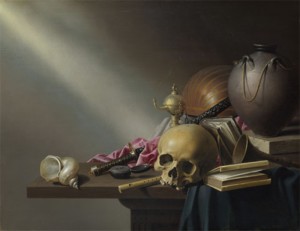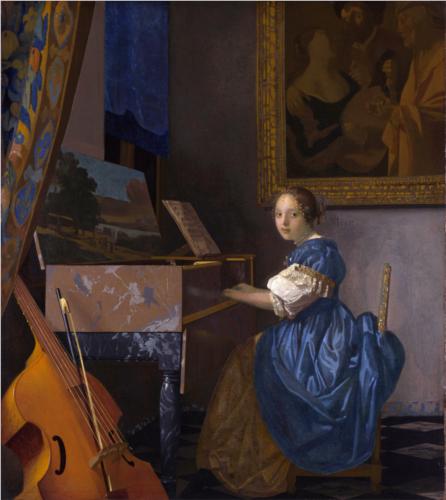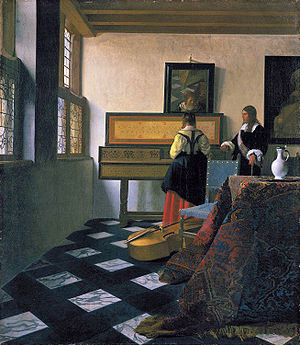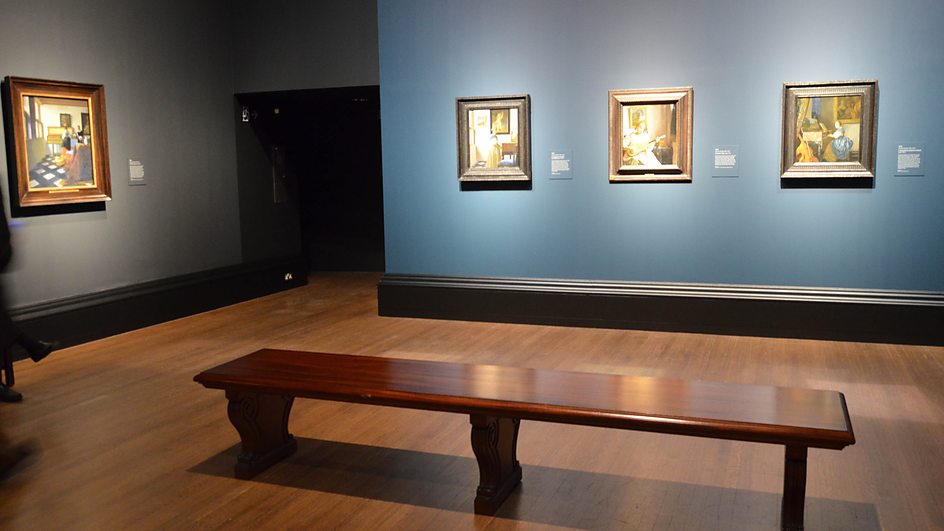‘If music be the food of art, play on’ – Rachel Campbell Johnston, The Times
Painting is traditionally seen as an art concerned only with the visual and the aesthetic, and similarly, music is considered a solely aural medium. This exhibition, however, attempts to prove that the two are inextricably linked, and to demonstrate how this phenomenon is evident in 17th Century Dutch art. By including rare musical instruments, a visual link is created between these objects and those in the paintings, and viewers are also reminded that the creation of these fine, intricate instruments is an art in itself.
The first room, entitled ‘Music as attribute and allegory’ explores the connotations and symbolic significance of music when depicted in art. Music was a popular and important theme in Dutch art, and it carried a wide range of associations. Since there was no recorded music at the time, music was an art of performance and could be used to denote transience. The presence of musical instruments in Harmen Steenwyck’s ‘Still Life: an Allegory of the Vanities of Human Life’ symbolises human knowledge and the pleasures of the senses, but the work is dominated by a skull, an obvious symbol of death. Frans van Mieris the Elder’s ‘Self Portrait of the Artist, with a Cittern’ demonstrates the dialogue between painting and music: since music was considered to be the more sophisticated of the two, it was often referred to in an attempt to raise the status of the sitter. The works of the first room engage well with the works of the second, which feature musical companies and festive galleries. The poignant contrast between instruments being played and lying still emphasizes the change in atmosphere that music can bring to a work.
The third and fourth rooms also form a cohesive dialogue, this time on the quantity of musicians in each work. The works in the third room all feature ‘intimate duets’, and they explore the role of music in developing romantic relationships, and the metaphor of music as harmony. Music provided a channel of unsupervised communication for young men and women at the time, as it was one of the only activities that did not require a chaperone. These works contrast well with the solo musicians featured in the fourth room, who either appear lost in solitude or open to participation. Vermeer’s ‘Young Woman seated at a Virginal’ looks out to the viewer, inviting them to join her in a duet by picking up the viola de gamba that lies suggestively in the foreground. The inscription on the virginal in Vermeer’s exquisite ‘The Music Lesson’ (Royal Collection) translates as ‘music is a companion in pleasure and a balm in sorrow’, emphasizing music’s emotional power and importance.
An informative aspect of the exhibition is the focus on the technical aspects of Vermeer’s work, which gives visitors an interesting insight into his inventive methods. Extreme close-ups provide an opportunity to see in precise detail how Vermeer achieved certain effects, like dappled sunlight on hair, or the wood-grain appearance of instruments. Scientific examination explains how the underpainting and surface layers react, and how physical traces of Vermeer remain, in brush bristles and even a fingerprint or two. The display emphasizes the importance of close, scientific examination of artworks and opens up this area of research to the public.
The exhibition is however, not without fault. It successfully expresses how music was an integral part of 17th Century upper class life in the Dutch Republic, but there is no coverage of music-making scenes featuring peasants and the working classes, which is a pity. Vermeer himself completely neglected these figures in his oeuvre, but they appear frequently in works by his contemporaries, such as Jan Steen. Visitors may also be disappointed, as I was, in the lack of works on loan from external sources. Nicholas Penny (director of the National Gallery) did state previously that the exhibition was intended to be based around works in the gallery’s permanent collection, but I must admit I was expecting, after paying £7 (with no concession option for students), a little more bang for my buck. The underlying intention seems to be to gain publicity and profit from the loan of the Kenwood House Vermeer.
That being said, the exhibition is evocative, informative and clearly laid out. The inclusion of live music performed by the Academy of Ancient Music is also a bonus if you visit at the right time, and the element of multimedia is quite effective and refreshing. The exhibition presents a striking contrast between stillness and movement, between silence and sound, just as Vermeer aimed to do all those years ago.
For more information please visit the National Gallery’s website.
The Exhibition continues until 8th September






